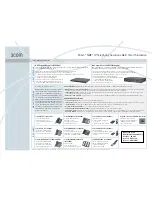
113
BusinessPhone – Dialog 4224 Operator / Dialog 3214
Glossary
Diversion
Incoming calls to an extension are diverted to
another directory number (extension, Common
Abbreviated Number or the operator).
There are three possibilities:
1. Direct, which means that all calls to an
extension are forwarded directly.
2. On no reply, which means that a call is
forwarded if it is not answered within a certain
time.
3. On busy, which means that a call is
forwarded if the extension is busy.
See section “
Call Forwarding
” on page 54.
Diversion Bypass
This is useful for letting urgent calls through to
an extension where diversion is active. See
section “
Call Forwarding
” on page 54.
Extension
All telephones connected to the PBX have a
unique internal number. If your telephone is
equipped with a display, you can see your
number.
Forced release
Disconnecting a third (undesired) party during
Intrusion. See section “
Outgoing Calls
” on
page 23.
Function code
A digit code that corresponds to a specific
function.
Group call
A group of extensions can have a common
number beside their individual extension
numbers. Any extension within the group can
answer the call.
Hold
To put a call on hold. See section “
During Calls
”
on page 35.
Identification
If an extension is busy, the operator can identify
the other conversation party.
Information
Internal callers are informed about absence
and time of return. External callers are diverted
to the operator, where the same information is
available. The operator can insert text or voice
information for any extension in the system.
This is useful for keeping the stored information
up-to-date for colleagues who are out of their
offices. Information can be of three kinds:
1. Pre-programmed text information.
2. Text information (only to display phones).
3. Voice information.
Intercom Line
A two-way direct call function between two
extensions, for instance an executive-secretary
communication. See section “
Other Useful
Features
” on page 86.
Intrusion
To intrude on an ongoing call when a requested
extension is busy. See section “
Outgoing Calls
”
on page 23.
ISDN
Integrated Services Digital Network. Provides
your system with supplementary services from
the public net. See section “
ISDN Facilities
” on
page 81.
Least Cost Routing
A function that automatically selects the
cheapest way to connect your external call (not
necessarily the shortest distance).
See section “
Least Cost Routing
” on page 91.
Loop keys
The operator can use the three Loop keys to
supervise call progress when placing calls with
a free or a busy extension. A call that is being
placed or is put on hold via a Loop key can be
retaken at any time.
Loudspeaker Paging
All members of an extension group are paged,
i.e. receive a short, sharp tone on the
loudspeaker followed by a Voice message from
the sender. See section “
Group Features
” on
page 76.








































